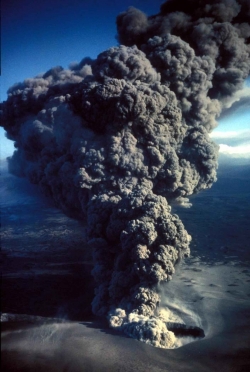A long time ago, before we used science to figure out how the earth works, people believed that dragons lived in the mountains. What else would explain those big bursts of flame or smoke out of the top? What else would explain the giant lizard bones they found in the rock? We know now of course that these were dinosaur bones. We found some answers to the smoking mountains, as well. How did we figure this out though? Let's go back to that time to tell anyone who is scared of dragons what's really going on.
We need to figure out why fire suddenly starts pouring out of some mountains. How will we go about it? We'll want to stay far away, but we still want to be good scientists. Let's hear some stories about volcanoes. People may tell us that it began with a rumble and was followed by a groan, as if a dragon was waking. Then the mountain began to smoke like a chimney stack until . . . BOOM! Rocks rocketed out of the mountain top, followed by a flow of fire! A
volcano is a mountain that lets out lava, gas, and ash from the earth's center. There are exactly 1,510 volcanoes in the world that could go off at any time. Most of them stay asleep and let's hope they stay that way.

Volcanoes, when the Earth goes boom.
Now that we know what a volcano is, let's ask some questions. Why do some blow up while others remain asleep? A long time ago, people might have said that it depends on whether the dragons wanted to sleep or not. You know better, though. Let's get out a map and start looking at which mountains will spit fire and which will not. Maybe that will give us some answers. We'll use little red pins for every place there's a story about a volcano erupting. As you mark them, you will notice a lot of these volcanoes are close together and form lines.
Distribution means how something is spread out. Your classroom has chairs evenly distributed around the room. The land we marked has an even distribution of volcanoes around their edges. Hey, these pins look like they make a shape . . .
You'll sees that our little red pins go up the left side of North and South America, curve over, and then come down the right side of Asia. We just drew a big red circle around the Pacific Ocean with Hawaii in the middle.
The Ring of Fire is a circle of volcanoes that goes around the Pacific Ocean and is home to 75% of the volcanoes on Earth. What's going on? Either dragons like beaches or we are starting to figure something out. I think you can guess where we're going next . . .
We'll search the bottom of the ocean. We know how volcanoes act, so let's look for some of the same stuff we see on the surface of the earth. Sure enough, on the sea floor, there are holes that warm the water and seem to go down deep into the earth.
Fissures are very long, deep cracks in the crust that are found in the middle of the ocean. We can find some of them in the middle of the Pacific and Atlantic oceans. If we watch long enough, you will see that new land slides out of them, like paper out of a printer . . .
With what we have found, you can put together one part of the mystery. For that much lava to shoot that high into the air from a volcano, it would have to come from deep in the earth, just like the new land that's sliding out of the sea floor. Still, it looks like our questions have just begun. Unless dragons are living in the middle of the earth, we have got some more searching to do. Where does that lava come from? How does it shoot out like a firework only higher and hotter and brighter? There's something happening below the crust . . . but what? And why? Hold onto that map. We're going to need it.
References:
Science Kids. "Earth Facts--Fun Volcano Facts." Science Kids, 2011. <
http://www.sciencekids.co.nz/sciencefacts/earth/volcano.html>
About.com. "Geography--Pacific Ring of Fire." About, 2014. <
http://geography.about.com/cs/earthquakes/a/ringoffire.htm>
Universe Today. "All About Volcanoes." Universe Today, 2009. <
http://www.universetoday.com/44445/all-about-volcanoes/>